After 16 years of development, Bitcoin accounts for only 0.22% of the global wealth of $90 trillion, remaining a tiny asset.
Author: Bill Qian
This article is a sister piece to "How to Protect Your Wealth in Turbulent Times," where we will discuss several questions step by step. First, what exactly is a store of wealth; second, why has gold become the modern winner; and third, why Bitcoin may be a better "gold" for the 21st century and beyond.
For the past 5,000 years, there has been competition for the title of "best store of value," but gold, with its scarcity and the value consensus formed over millennia, has gradually become the king of wealth storage. At the same time, Bitcoin is slowly eroding and shaking gold's market position, bringing epic opportunities for wealth creation and transfer to our generation in the process.
The History of Money
To compare gold and Bitcoin, let's first talk about the largest category in this realm: money. Money has three core functions: medium of exchange, unit of account, and store of value. From shells and copper coins to modern fiat currencies (like the US dollar and euro), the medium of exchange and unit of account have continuously evolved. Meanwhile, gold, silver, land, and blue-chip stocks have long been mainstream choices for storing value. In the history of currency, the US dollar during the Bretton Woods System was one of the few currencies that could simultaneously fulfill the three functions of medium of exchange, unit of account, and store of value, but this was an exception rather than the norm; moreover, the dollar's role as a three-in-one currency gradually unraveled after Nixon's televised speech in 1971. Some might ask: why do many people in emerging markets still wish to use and save in dollars, even when data shows the dollar is continuously depreciating? I believe the answer is: because they have no better choice; their local currencies are worse. This topic leads us to stablecoins, which we will discuss next time.
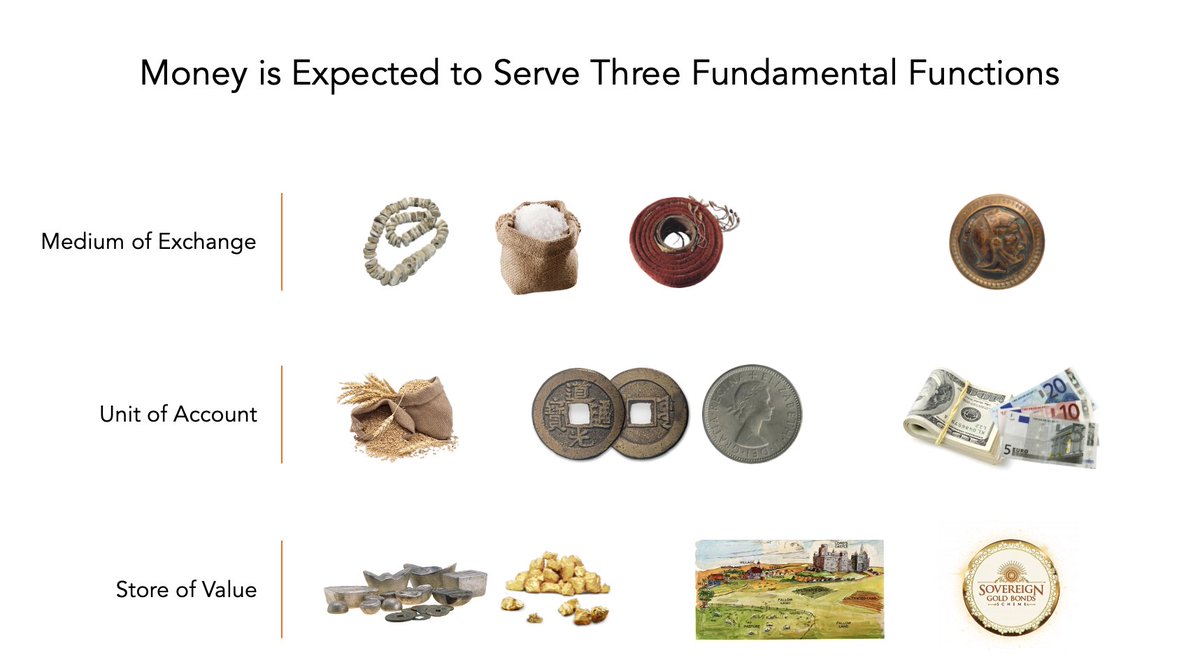
How Did Gold Become Today's "Gold"?
A good store of wealth must meet five characteristics: scarcity, durability, portability, divisibility, and social consensus. Silver, land, and diamonds struggle to surpass gold on these five metrics. Thus, after thousands of years, gold has finally won the consensus and mindset of humanity, becoming almost the sole target for wealth storage.
What Are the Limitations of Gold?
Storing gold requires expensive secure vaults and insurance, and sometimes even transportation costs, which increase with the amount stored. During World War II, the gold in the Paris bank vault was directly plundered by the German army, which taught me a significant lesson: the safe in the bank is not safe at all.
In extreme times, the cost of liquidating gold is very high. Similar situations occurred during World War II; whether you were in Shanghai, Paris, or Amsterdam, gold transactions often faced high discounts, typically 30-50% lower than spot prices, with even larger discounts in high-risk environments. Worse still, trading gold in conflict zones often comes with severe personal risks—once others know you hold gold bars, robbery and kidnapping are always possible.
Governments can further undermine the reliability of holding gold through confiscation and price controls. For example, in 1933, the US required citizens to surrender most of their gold at a fixed price below market value, or face severe penalties. Note that at that time, the US government demanded all citizens' gold be surrendered at a fixed price of $20.67 per troy ounce. Subsequently, in 1934, the Gold Reserve Act revalued the official price of gold to $35 per troy ounce. This meant that the gold held by citizens was "devalued" by about 41% in just one year. The US confiscated over 2,600 tons of gold, directly altering monetary policy and laying the groundwork for the complete end of the gold standard in 1971. All of this happened in the country that may have respected private property rights the most in the world, the United States of the 20th century.
Additionally, in today's digital economy, gold's limitations in being "digital" are also evident. For instance, you cannot send one kilogram of gold to your friend or another address via any electronic wallet.
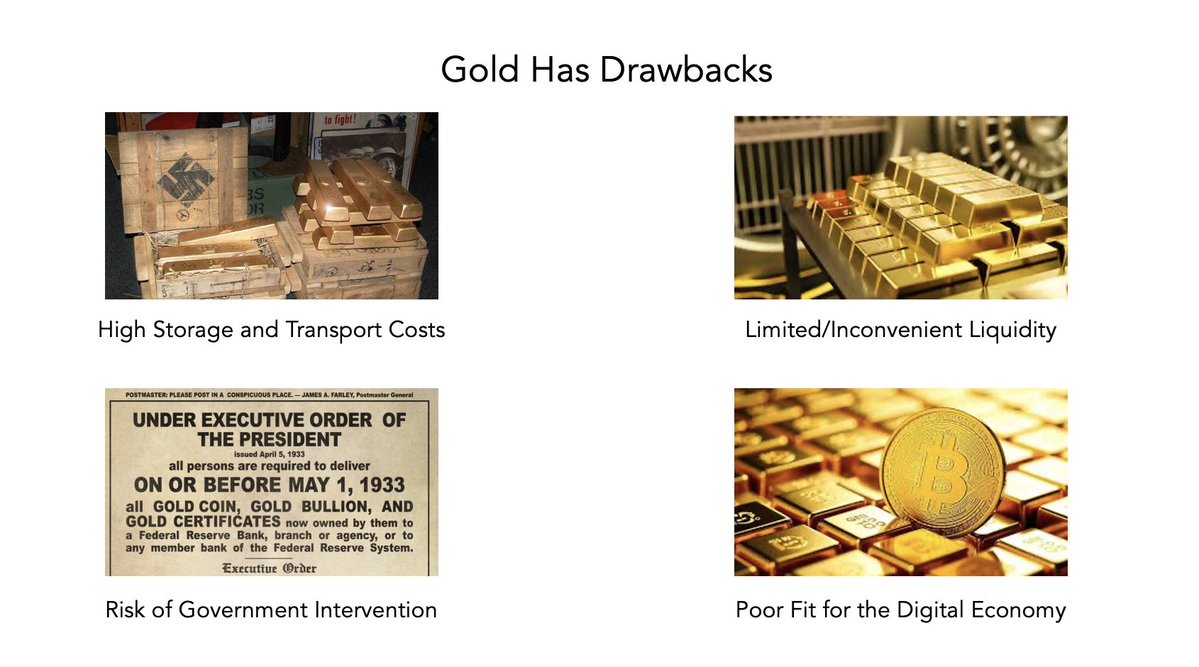
Bitcoin Emerged in 2009! What Is It?
In 2009, Bitcoin was created by the pseudonymous Satoshi Nakamoto, becoming the first decentralized digital currency. It operates on a global, public, open computer network (commonly known as blockchain, a term I find quite difficult to understand)—a shared digital ledger that anyone can participate in and verify. New bitcoins are generated through "mining": computers solve complex mathematical problems, package transactions into new "blocks," and add them to the blockchain, with "miners" receiving newly generated bitcoins as rewards. This process ensures the security and smooth operation of the entire system.
What Are the Characteristics of Bitcoin?
Scarcity: With a total supply capped at 21 million, Bitcoin avoids the 1.5%-2% inflation that gold experiences due to mining.
Durability: As a digital asset, it is perpetually durable and does not suffer from physical wear and tear.
Portability: Today, carrying $1 million worth of gold through a war zone is nearly impossible. At current prices, $1 million of gold weighs 12.4 kilograms, which you cannot take on a plane, and driving with it is even more dangerous. However, Bitcoin does not have this problem.
Divisibility: Bitcoin is highly divisible, with the smallest unit being one hundred millionth of a bitcoin, which is already small enough for practical purposes.
Social Consensus: This has been perhaps the most debated point over the past 16 years and is the motivation behind various other coins challenging Bitcoin. Regardless of what Bitcoin and the Bitcoin community have done right over the past 16 years, we must accept one fact today: it has formed a preliminary social consensus. By 2024, the most powerful people in the world, Trump and Putin, will recognize Bitcoin, albeit for different reasons. Trump sees it as innovation, a tool for debt relief, and a free and open capital market for the Trump family to enjoy; Putin recognizes Bitcoin because Russians have discovered that with Bitcoin and the blockchain network, NATO's sanctions against Russia over the years are merely paper threats. Without the SWIFT network, Russians still have the blockchain network. Additionally, Larry Fink, founder of the world's largest asset management company BlackRock, has publicly supported Bitcoin since 2023 and plans to launch a Bitcoin ETF in 2024, calling it "digital gold." Larry manages $12.5 trillion, equivalent to 11% of the global GDP in 2024. Then there's Musk, the richest businessman in the world, whose endorsements are numerous and need no elaboration.

Let's Take a Look at Bitcoin's Market Performance
Since 2010, Bitcoin's average annualized return has reached 167%, 14 times that of the S&P 500 index and 24 times that of gold. Today, its market capitalization of $2.3 trillion has surpassed that of global silver ($2.1 trillion) and the largest fuel provider for human civilization, Saudi Aramco ($1.8 trillion). As a "one-person enterprise," Bitcoin can be considered the most leveraged enterprise in history. When discussing the leverage of an individual's talent, it is generally believed there are four types: labor, capital, code, and media. However, the driving force behind leveraging these four is, I believe, the ability to tell stories, as ultimately, this world is driven and shaped by storytellers, from religious leaders to Marx to Satoshi Nakamoto. Satoshi is a great storyteller.
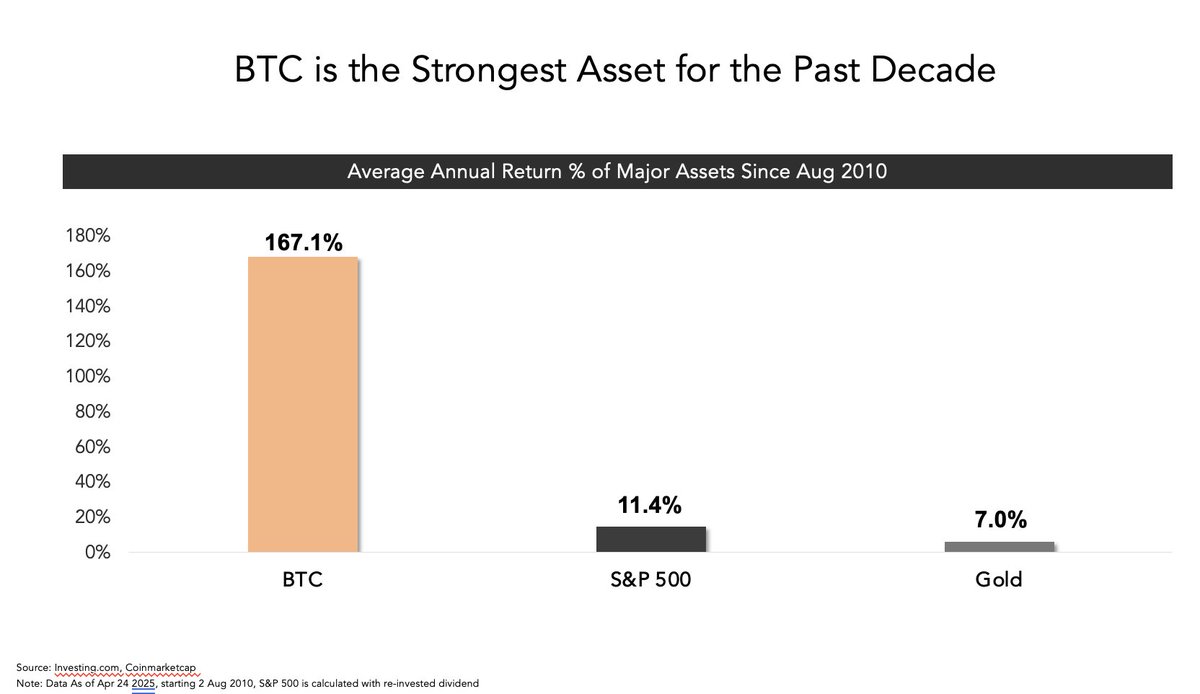
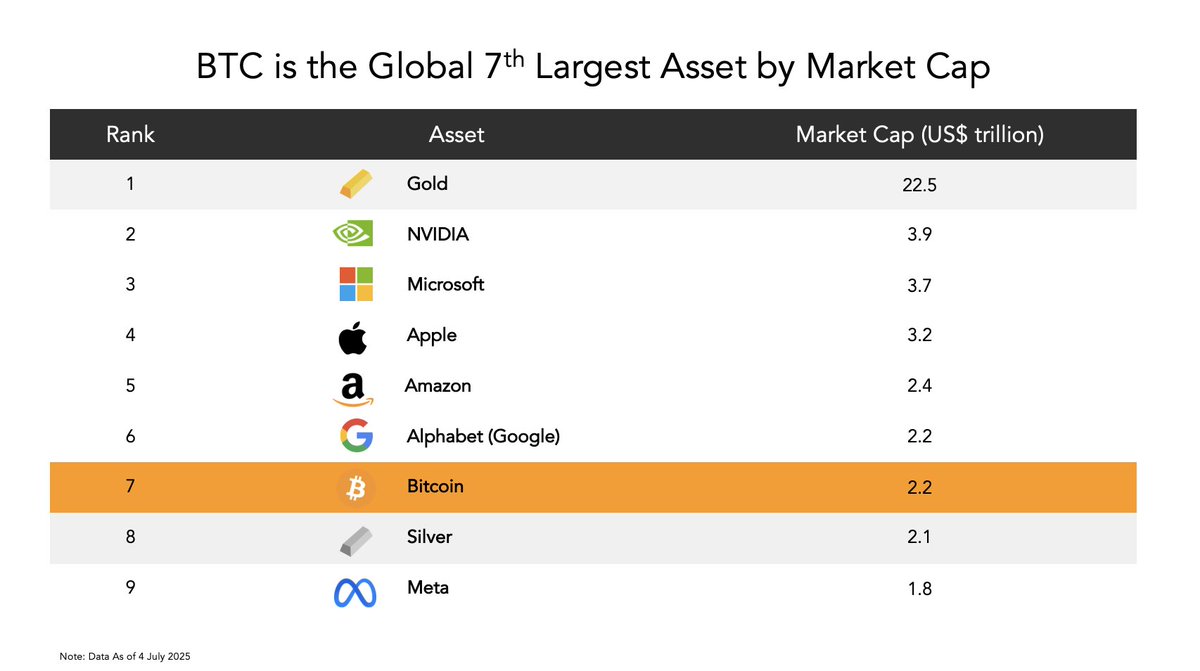
The Future Outlook for Bitcoin
After 16 years of development, Bitcoin accounts for only 0.22% of the global wealth of $90 trillion, remaining a tiny asset. Currently, there are about 100 million Bitcoin holders worldwide, accounting for only 2.5% of the 5.6 billion internet users. This means that Bitcoin's adoption rate is still in its early stages, equivalent to the "innovator stage" of a broader market. This situation is similar to the internet's adoption in 2000-2001—at that time, there were about 400 million users, close to today's approximately 450 million cryptocurrency users, both marking an initial growth period.
If in the future, the number of Bitcoin holders increases from 100 million to 5.6 billion (equivalent to today's internet user count), and it gains widespread adoption by global institutions and sovereign governments, what would Bitcoin's price reach? This is also why many people attempt to predict that Bitcoin will soon reach $1 million, as $1 million would essentially bring Bitcoin's market capitalization in line with today's gold market capitalization.
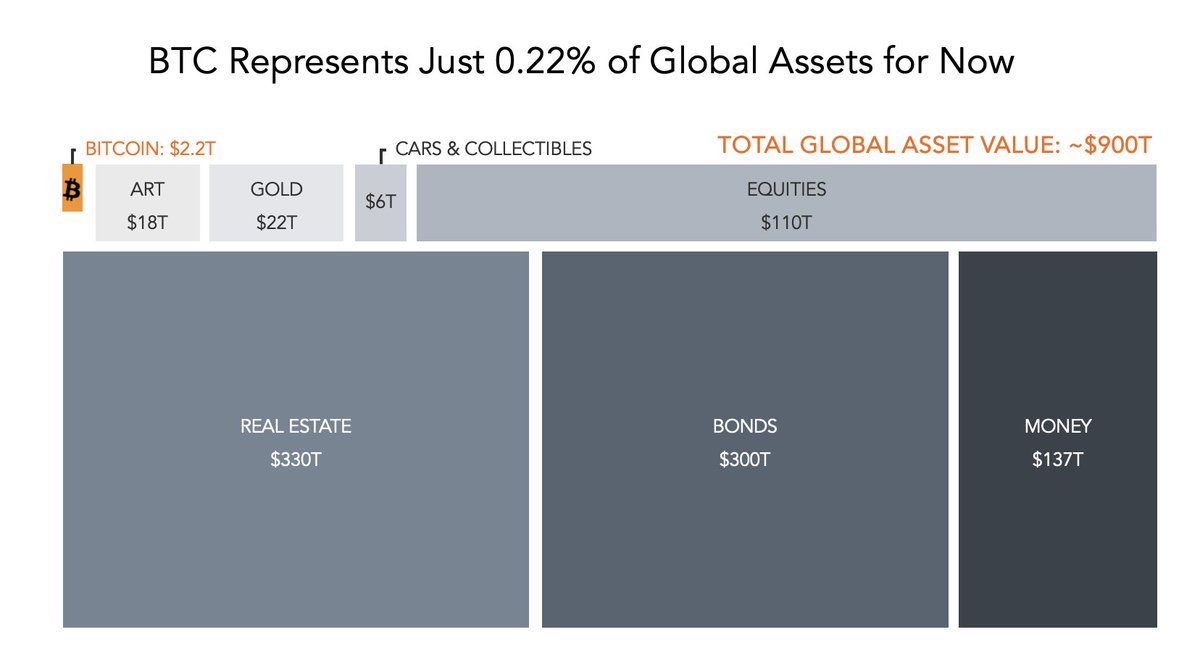

Finally, what can you do? Start building your own Bitcoin holdings.
First, establish your investment horizon. Historical data shows that most investors perform poorly in market timing. Unless equipped with exceptional tools, discipline, and the ability to capture high-frequency signals, long-term strategies—such as passive investing, dollar-cost averaging, and disciplined rebalancing—are often more effective than attempting to predict market fluctuations. A time-weighted approach, such as consistently investing in Bitcoin over the next 12–36 months, is a more prudent strategy. Friends often ask me recently, as beginners, if they should dive in all at once. I believe everyone should strive to be a rational contrarian investor, remaining skeptical and cautious when everyone else is emotionally exuberant. This is also why I have always recommended dollar-cost averaging; it acknowledges one's own insignificance in predicting market movements, and recognizing this insignificance already puts one ahead of the majority.
Second, determine your reasonable allocation ratio. Allocating at least 5% of your household net worth to Bitcoin is a cautious starting point. This aligns with traditional portfolio strategies, which typically allocate 5–15% to gold (a safe-haven asset) to enhance stability and reduce risk. For example, Ray Dalio's All Weather portfolio allocates 15% of assets to Hard Assets (gold/commodities). Therefore, I believe 5% is a good starting point.
Third, take action. You can directly ask your AI assistant: "As a user who has completed KYC verification and resides in [insert jurisdiction], how should I purchase Bitcoin?"
免责声明:本文章仅代表作者个人观点,不代表本平台的立场和观点。本文章仅供信息分享,不构成对任何人的任何投资建议。用户与作者之间的任何争议,与本平台无关。如网页中刊载的文章或图片涉及侵权,请提供相关的权利证明和身份证明发送邮件到support@aicoin.com,本平台相关工作人员将会进行核查。




